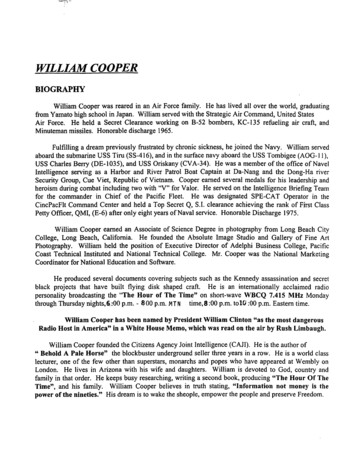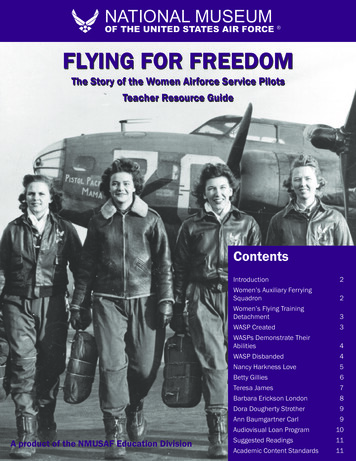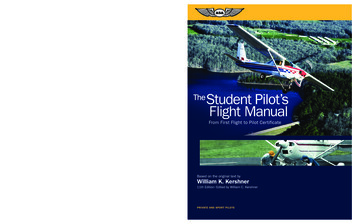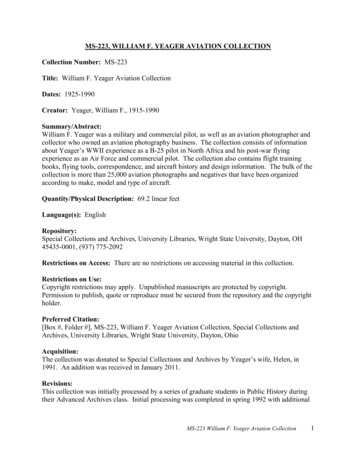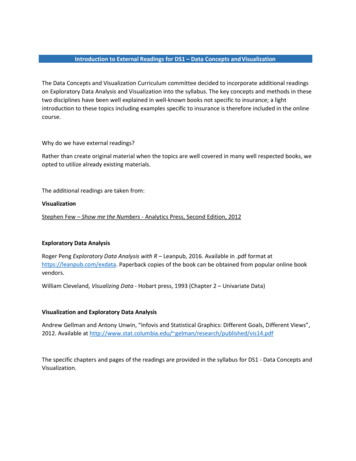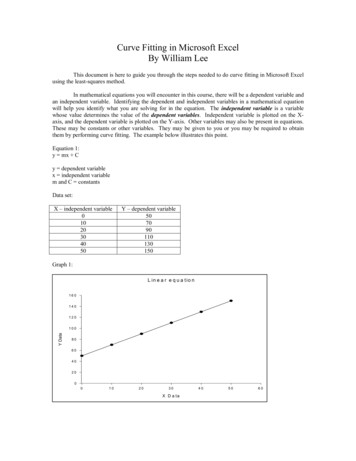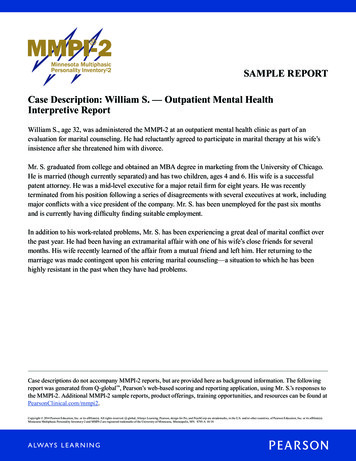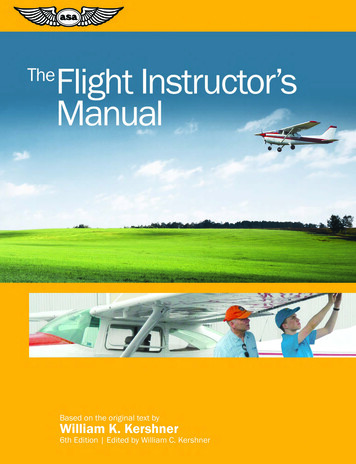
Transcription
William K. Kershner began flying in 1945 at the age of fifteen, washing and propping airplanes to earn flying time. By this methodhe obtained the private, then the commercial and flight instructor certificates, becoming a flight instructor at nineteen. He spent fouryears as a naval aviator, most of the time as a pilot in a night fighter squadron, both shore and carrier based. He flew nearly threeyears as a corporation pilot and for four years worked for Piper Aircraft Corporation, demonstrating airplanes to the military, doingexperimental flight-testing, and acting as special assistant to William T. Piper, Sr., president of the company. Bill Kershner held adegree in technical journalism from Iowa State University. While at the university he took courses in aerodynamics, performance,and stability and control. He held the airline transport pilot, commercial, and flight and ground instructor certificates and flewairplanes ranging from 40-hp Cubs to jet fighters. He is the author (and illustrator) of The Student Pilot’s Flight Manual, TheInstrument Flight Manual, The Advanced Pilot’s Flight Manual, The Flight Instructor’s Manual, and The Basic Aerobatic Manual.Kershner operated an aerobatics school in Sewanee, Tennessee using a Cessna 152 Aerobat. He received the General Aviation FlightInstructor of the Year Award, 1992, at the state, regional and national levels. The Ninety-Nines awarded him the 1994 Award ofMerit. In 1998 he was inducted into the Flight Instructor Hall of Fame, in 2002 was installed in the Tennessee Aviation Hall of Fame,and in 2007 was inducted into the International Aerobatic Club Hall of Fame. William K. Kershner died January 8th, 2007.Editor William C. Kershner received his early flight training from his father, William K. Kershner. He holds Commercial, FlightInstructor and Airline Transport Pilot certificates and has flown 22 types of airplanes, ranging in size from Cessna 150s to Boeing777s, in his 15,000 flight hours. He works as an airline pilot and lives in Sewanee, Tennessee.——To my wife, Bettyand to the flight instructors, pilots, and others in aviation who tried to improve my aeronauticalknowledge over the years: Pat Howell, Arch Agee, Horace Draughon, Waldo Rassas, Frank Knapp,Wade Hadley, Buford Ledbetter, Baxter Lehman, Clyde Brown, Piedmont Poindexter, L. M. DeRose,Truman W. Finch, E. B. Salsig, and many others to whom I owe much thanks.W. K. Kershner——The Flight Instructor’s ManualSixth EditionWilliam K. KershnerIllustrated by the Author 2006–2017 Kershner Flight Manuals, LLC. Previous editions 1974–2002 William K. Kershner.First Edition published 1974, Iowa State University Press. Fifth Edition published 2012 by Aviation Supplies & Academics, Inc.All rights reserved. No part of this book may be reproduced in any form or by any electronic or mechanical means, including information storage and retrieval systems, without permission in writing from the publisher, except for brief passages quoted in a review.Cover photo credits: Andrey Ushakov – Fotolia.com; iStockphoto/Nancy NehringPhotos of Bill C. Kershner and sons, on the front cover and page vii, were taken by and are courtesy of Donna Kershner.Aviation Supplies & Academics, Inc.7005 132nd Place SE, Newcastle, WA 98059Email: asa@asa2fly.com Internet: www.asa2fly.comASA-FM-CFI-6-PD978-1-61954-614-1
ContentsIntroduction, vPart OneFundamentals of Flight Instruction1 On Being a Flight Instructor, 1-12 How People Learn To Fly, 2-13 Anatomy of a Flight Lesson, 3-1Part TwoPresolo Instruction4 The First Flight, 4-15 The Second Flight, 5-16 High Work—The Confidence BuildingManeuvers, 6-17 Low Work—Wind Drift CorrectionManeuvers, 7-18 Introducing Emergency Situations, 8-19 Elementary Stalls, 9-110 Shooting Takeoffs and Landings—andSolo, 10-1Part ThreeFirst Solo to the Private Certificate11 The Postsolo Visual Maneuvers, 11-112 Teaching Emergency Flying by Referenceto Instruments, 12-113 Night Flying Instruction, 13-114 Cross-Country—Ground Instruction, 14-115 Cross-Country—Flight Instruction, 15-116 Transition from Student to Private Pilot, 16-1Part FourAdvanced VFR Instruction17 Instructing in Complex Single-EngineAirplanes, 17-118 Instructing in the Light Twin, 18-119 Advanced Ground Reference Maneuvers, 19-1Part FiveIntroduction to Aerobatic Instruction20212223Introducing Aerobatics, 20-1Spins, 21-1The Three Fundamentals of Aerobatics, 22-1Combinations and Variations of the ThreeFundamentals, 23-1Part SixInstrument Instruction24 Basic Instrument Instruction, 24-125 Communications, Navigation, and ATC, 25-126 Putting It All Together, 26-1AppendicesA G Effects on the Pilot During Aerobatics, A-1B Flight Instructor Performance Tips, B-1C Spin Syllabus, C-1Bibliography, Bib-1Index, I-1iii
IntroductionThis book is a reference for those in the process ofworking on the flight instructor’s certificate and aguide for the new instructor.I believe that too often newly certificated instructors feel they are left “on their own” and need a writtenreference to which they can turn for information aboutstudents’ and more advanced pilots’ problems that theywill encounter. I’ve tried to list common errors in eacharea or maneuver and have suggested methods of coping with them.The manual is set up so that an instructor who isstarting to teach advanced stalls, for instance, can referto that chapter for suggestions without reading the restof the book. While each chapter is a part of the wholebook, I’ve tried to write each so that it can be used byitself as a reference for a particular phase of instruction. As an example, the advanced stall material repeatssome of the common errors noted earlier in the chapteron elementary stalls. Or a chapter on other advancedflying may cover a review and lead-in from the moreelementary sessions.The reader will note that I advocate the teaching ofintegrated ground and flight instruction, rather than ablock of ground school that doesn’t apply to the flyingat that time. Lest it appear that I am a late convert tothe system, I have been using this method of instructing with every student I’ve worked with since 1949,and The Student Pilot’s Flight Manual was publishedin 1960 using this approach, I believe, for the first timein print. I feel that this is the best technique to keep thestudents’ interest and to help them learn.The Flight Instructor’s Manual, with minor variations, parallels the material as presented in The Student Pilot’s Flight Manual, The Advanced Pilot’sFlight Manual, The Basic Aerobatic Manual, and TheInstrument Flight Manual. This might be consideredthe instructor’s text for those four manuals; and it is a“how to instruct” guide rather than a detailed text onthe basics. The other manuals should be used for detailsas they would be presented to the new pilot.Again, as in my other books, changes were madeby the FAA in forms and releases during the processof writing. I’ve tried, in most cases, to stick to thegeneral idea of teaching people how to become safepilots. As you work on the flight instructor’s certificate, use this manual for the principles, but refer to yourFlight Standards District Office for the latest specificrequirements.I’ve been fortunate in that a number of knowledgeable individuals aided in the process. Any errors aremine, however.W. K. Kershner’s Acknowledgmentsfor the 1st–4th EditionsI wish to thank the following people:The late Bill Whitmore of the Nashville FSDO,whose knowledge of and common sense approach toinstrument flying I particularly respect. Many of hissuggestions were used here.The late Lonnie Thurston of the Nashville FSDOgave me many good ideas about ground referencematerial.Stanley Mohler, M.D., former head of the Aeromedical Applications Division of the FAA at Washington, who has visited Sewanee several times and withwhom I have flown aerobatics in the checking of physiological effects of g forces on the pilot. His suggestionsand information sent on that subject were very valuableto me in writing on aerobatics instruction.Leslie McLaurin, airport manager at Sewanee, whoread the complete manuscript and made good comments and suggestions that were incorporated.Glen McNabb, flight instructor of Jasper, Tennessee, who let me use him as a “test project” while hewas working on his certificate several years ago. Someideas from his notes were used here.Evelyn Bryan Johnson, flight instructor at Morristown, Tennessee, who reviewed the first half of thebook and whose comments were much valued.v
Genie Rae (Mrs. Dave) O’Kelley, flight instructorof Knoxville, whose attitude toward instructing shouldbe copied by more of us.Bob Bomar, veteran flight instructor of Shelbyville,Tennessee, with whom I’ve discussed flying andinstructing many times over the years and whose opinions I respect highly.Major Gary L. Moore, U.S. Army, for his paper“Integrated Flight Instruction,” as part of his postgraduate work at Middle Tennessee State University.John Anderton, former flight student at Sewanee,now a captain with U.S. Air, whose work with a camerain several spin sessions was above and beyond the callof duty.The late Louis Cassels and Nation’s Business forpermission to refer to Mr. Cassels’s article “Eight Stepsto Better Training” (published March 1961, Nation’sBusiness, 1615 H Street N.W., Washington, D.C.—check for reprints).William E. Wells, who came to take my aerobaticsprogram and left me with very useful copies of his ownwork in setting up flight instruction syllabuses.I must acknowledge the help I received from CessnaAircraft Company. My work with Ed McKenzie, JoyceCase, and Jim Kemper on the Cessna 150 AerobatManual remains one of the most enjoyable times of mywriting career. Bill Thompson, Engineering Testpilotat Cessna, gave me the benefit of his knowledge and hefurnished concrete help in the form of reports. I appreciate very much Cessna Aircraft Company’s permissionto use sections of the Aerobat Training Manual in thepart on aerobatics.James S. Bowman, Jr., of the NASA Spin Tunnel atLangley answered my questions on the subject, makingme realize how much there is to learn.Thanks must go to Callie Hood, Barbara Hart,Denise Childers, and Judy Rickman for typing thesmooth copy of the manuscript; to my wife, Betty, whotyped the rough copy; and to my daughter, Cindy, whohelped arrange illustrations. Nan Thomas at the University of the South was helpful with facilities there.In the second edition, Rowena Malone and JudyTimberg made further improvements in presentationand readability.Working with editor Lynne Bishop has been a pleasure, not only on this 4th edition but also on my otherbooks and editions. Her humor and astute advice havesaved me from editorial disaster more times than I needto mention.Thanks to Catherine Cavagnaro, CFI and professorof mathematics at the University of the South, for flying the glide tests in chapters 4 and 8 and helping withthe cover of the fourth edition.viAppreciation is expressed to James W. “Pete”Campbell of the FAA for his efforts on behalf of flightinstructor refresher clinics through the years and mostof all for making FARs interesting. Figure 17-8 wasinspired by one of his talks; other ideas on principlesof instructing germinated at Pete’s clinics.Thanks to Scot Oliver of Sewanee for his aid inmaking movies of spins.Special thanks to George Naff who came to takemy aerobatics course and left me most useful ideas ofsyllabuses for this book.The term Pilot’s Operating Handbook is used hereas a term to include the older airplanes’ Owner’s Manuals and/or Airplane Flight Manuals and other manufacturers’ operating information.As this book has to be a general approach to flying, the Pilot’s Operating Handbook procedures for aparticular airplane will naturally take precedence overprocedures indicated—for example, use of carburetorheat, flaps, spin entries, and recoveries.The instrument markings in the illustrations aregenerally close to those expected for the type of airplane being discussed, but in most cases the “numbers”(VS0, etc.) have been fictionalized.Needless to say, none of the performance or navigation charts are to be used for actual flight, but areexamples for discussion.A Note on the Fourth EditionThanks to Margaret Morrison and Tom Jones of theRichmond FSDO, former aerobatic trainees of minefor their input and information in writing this edition.Also, thanks to Catherine Cavagnaro, math professor and CFI, for helping with glide and other flightexperiments.Thanks also to Elizabeth Motlow for the photo forthe cover of this edition.The latest FARs and government publications havebeen checked for in this edition, but you should checkwith your FSDO and other sources for changes inFARs! (Fortunately, flying and instructing basics willremain basically the same.)In the flight manuals I’ve often had to use the words“he” and “him” to refer to students, just because it’simpossible to mention both men and women everytime. However, an increasing number of flight instructors and students are women, and these manuals aremeant to be for and about them as well as their malecounterparts.I would appreciate comments from flight instructors who use the book.W. K. Kershner
Acknowledgments forthe Fifth EditionA novice pilot’s entire flying life is influenced by theCFI, especially that initial instructor. The value of thatfoundation is too often under-appreciated.My thanks to Jackie Spanitz, Jennie Trerise, SarahHager, Laura Fisher and Kelly Burch from ASA fortheir guidance and technical expertise in producingthis edition. Linda Schumm (CFI and Chief of AviationSafety for the Illinois Department of Transportation)and Rebecca Gibson (CFI and manager of the SewaneeAirport) gave me good insight in teaching primarystudents in technologically advanced (i.e., distractionfilled) airplanes. Thanks to Jim Efird for catching mymistake on teaching slips pre-solo.The fifth edition of The Flight Instructor’s Manualis dedicated to my sister, Cindy.William C. KershnerSewanee, TennesseeNotes on the Sixth EditionOne of the biggest changes to flight instructing recentlyis the advent of the FAA’s Airman Certification Standards. The ACS is a “from-the-ground-up” rework ofthe Practical Test Standards and a big improvementfor checkride preparation. ACS breaks the practicaltest down into very logical Areas of Operation (e.g.,“Traffic Patterns”) with subject matter references,followed by the task’sObjective and three subsets of the task: Knowledge, Risk Managementand Skills. The examineris required to include atleast one of the Knowledge and Risk Management points on the test,and evaluate all of theSkills requirements.You won’t find manydirect references tothe ACS in The FlightInstructor’s Manual,because this book iswritten to teach how toteach, and to have students gain the skills offlying safely regardlessof the latest methods ofrunning a checkride. Ofcourse, the ACS shouldbe used to ensure the student is fully prepared for thespecific requirements of the practical test.Additionally, 14 CFR Part 23 has been dramatically changed from prescriptive to performance-basedstandards. This greatly simplifies the regulations inhopes of making certification of new aircraft easierand cheaper, while lowering development costs with noloss of safety. The changes are somewhat analogous tochanging the requirements of building a garage from,“The trusses of the roof will consist of 2x6 lumber,spaced no farther apart than 16 inches, enabling theroof to withstand the weight of 6” of wet snow or windgusts up to 45 knots in dry conditions ” to, “The roof of a garage must be able to withstand the weight of 6” of wet snow or sustained windgusts up to 45 knots when dry without failure.”These new standards should allow for more innovation and will only apply to aircraft certified underthe new part (effective August, 2017). Removed arethe Normal, Utility and Aerobatic classes, replacedby “Normal” and “Normal approved for aerobatics.”The entire population of aircraft certificated under theold Part 23 will continue under that part, so it will besome time before you might encounter a airplane builtin accordance with the new FAA reg’s.—W. C. K.vii
1On Being a Flight InstructorBackgroundTHE FLIGHT INSTRUCTOR’S CERTIFICATE ISTHE MOST IMPORTANT ONE ISSUED. Unfortunately, it is not always viewed that way, but instead it isoften thought of as a “license to build up time” for otherflying jobs — or other certificates and ratings. If you’regoing to be a flight instructor (for whatever reason), bethe best while you are doing it.THE BEST FLIGHT INSTRUCTORS HAVE THEFOLLOWING THINGS IN COMMON:1. A KNOWLEDGE OF THE SUBJECT. They continually study to update themselves.2. THE ABILITY TO TEACH. They know how people learn and provide instruction appropriate to theindividual and the circumstance. Their instructionis accurate and properly sequenced.3. A GENUINE INTEREST IN THE LEARNER.They like working with people. The instructorstudent relationship is good and they have theconfidence of those who are learning. They haveconsideration of the student’s point of view.4. PROFESSIONALS IN THE AIR. They have skilland are self-disciplined in the airplane. Their relationship with students is that of friendly authority.(If they are authoritative only, that’s bad; if they arefriendly without authority they are ineffective andthe student will pay later.)5. ADAPTABILITY. If the old “proven” methodsdon’t work with a particular student, professionalflight instructors use new techniques, understanding that these new approaches apply only to theseindividuals.6. CONSISTENCY. They don’t change personality butuse the same standards from one flight to another.7. UPDATED INSTRUCTING TECHNIQUES.Every once in a while they take a look at themselves to see if they’ve gotten in a rut and changetheir outlook to rejuvenate their attitudes towardinstructing.Successful instructors’ goals of teaching are to:a. instill high standards in students;b. teach precision habits;c. reduce tolerances as instruction proceeds;d. detect unsafe habits and correct them (or, morepositively, teach safe habits from the beginning).Your InfluenceThe flight instructor exerts more influence on flightsafety than any other pilot. You may ask, “What aboutairline captains who fly thousands of passengers everyyear? Don’t they have more influence than people whomay instruct, at most, 30 people in that time?” Remember that those airline captains didn’t spring fully ratedinto the left seat; much of their attitude toward flying,and their flying habits, are the result of the first fewhours of their flight instruction. If they have been flightinstructors at some point in their careers, be assuredthat they passed on some of the ideas they got in theirearly learning period. This passing of information byflight instructors includes bad ideas as well as goodones, unfortunately.The student pilot tends to imitate his instructor:If you are the kind of person who thinks that FederalAviation Regulations are for less-experienced pilotsthan you, think about the effect on the student if youbuzz and show off at low altitudes. You might get awaywith it, but if a student gets in trouble because he wasinfluenced by your actions, you’d feel low enough toput on a 10-gallon hat and walk under a snake’s belly(and that’s low).It will bring the idea of your influence directly homewhen a student of 10 or 15 years ago stops by to say,“I’ll always remember that time we were doing stalls,and you taught me that ” You don’t even rememberflying with him, it’s been so long ago, but it has stuckwith him. Another time, you may hear about one ofyour ex-students who, after inadvertently flying into1-1
1-2IFR conditions, saved himself and his passengers byusing the emergency instrument flying instruction youhammered so hard at him. Your next reaction, though,after feeling that you’ve accomplished something, willbe to wonder why you weren’t able to instill enoughjudgment so that he would avoid getting into such asituation requiring the emergency training.Speaking of judgment, throughout this book scenarios will be used to show how to help the studentor low time pilot set up his own ideas of aeronauticaldecision making (ADM) or judgment calls.You will be an obvious example, and how youact during flight training will affect how the studentpilot makes his or her decisions in later years. You, theinstructor, may lecture about aviation safety, but unlessyou fly the way you talk, there will be faint hope ofstudent pilots taking you seriously.You may later see one of your private or commercial(or instrument, or instructor) trainees getting careless.Will your influence be enough to straighten him out?It’s good to know that people come from milesaround to get the word on flying because they knowthat you are the person who will give it to them straight.Use your influence to make these people fly safely.General ResponsibilitiesAs a flight instructor you will be responsible for:1. Starting a student, giving him ground and flightinstruction so that he may safely solo.2. Overseeing his solo flights in the local area.3. Giving periodic dual instruction to add to hisknowledge and to check his progress.4. Giving proper ground and flight instruction toassure him of safely flying the prerequisite amountof solo cross-country for the private certificate.5. Preparing him to pass the private knowledge testand check ride.That simple layout of requirements has a certainnow aspect as it stands. It boils down to (1) assuringthat he is safe to fly solo locally, (2) making sure that heis safe to fly solo cross-country, and (3) seeing that hecan pass the private check ride and not embarrass you.What’s not listed in the earlier list is implied. You’llmake sure that (a) 2 years from now he doesn’t neglectto preflight the airplane properly, resulting in problemsin flight, (b) 3 years from now he uses judgment andcancels a flight even at great inconvenience because ofweather he feels he can’t handle, or (c) 4 years after he’sleft you, he gets several hours of dual because he’s hitPart One / Fundamentals of Flight Instructiona slump and knows he needs instruction. Teach him torecognize his limitations.The same thing applies when you are working witha person on the commercial, multiengine, or instrumentrating or flight instructor’s certificate. You’ll actuallyhave three goals to accomplish:1. Teach the particular item so that he can move on tothe next phase.2. Give him knowledge so that he can continue tocomplete the requirements to get the particular certificate or rating.3. Teach him an attitude toward flying that is fixed inhis mind long after he’s forgotten exactly how to doa specific maneuver for the flight test.You teach an instrument student basic instrumentflying so that he will be ready to go on to radio workand take the practical test. After he takes the practicaltest, he will have to cope with the weather and ATCsystems, so your real objective is for him to be successful in doing that, not just the short range aim to pass thepractical test. The practical test is necessary becauseit covers areas of knowledge needed to cope with thesystem, but it’s poor policy for an instructor to train anindividual strictly for a practical test and even worse totrain for a particular check pilot. (“This check pilot isheavy on GPS work so we will work on that and won’thave to spend much time working on the VOR ” Boththe instructor and check pilot are wrong in this case.)You’ll see that your personal responsibility can beheavy. A long distance call from a town to which yourstudent left on a cross-country an hour ago can be quitea jolt until you find out he’s okay, except that he had aflat tire when taxiing in there and will be delayed. Or,you’ll worry about the student who should have beenback 30 minutes ago until (finally) you get his call onthe Unicom, or he comes into view over the horizon.You’ll be relieved and just a little peeved at him but willgive him a chance to explain before starting to discusshis shortcomings.You’ll feel the pressure, too, when you’ve workedwith a person for several weeks or months, recommended him for a particular certificate, and sent himup for the practical test. It can be a very long intervalfrom the time he taxis out with the check pilot untilyou find out he passed. You can remember all sortsof information that should have been covered in moredetail. Of course, his busting a practical test is not agrave event — compared to his having an accident —but you’ll sweat the practical test anyway.Another of your responsibilities to the student is tobe truthful if one of your demonstrations goes awry.Most of the times you goof will be obvious (or at least
Chapter 1 / On Being a Flight Instructorthat wasn’t the way you explained it on the ground), sotell him that was not the way to do it. Then, when youdo it slickly and say that is the way, he’ll trust you.Always be ready to add to your instruction. Manytimes an unplanned event gives a good opening to addsome knowledge of flying. (“Notice how smooth the airgot when we climbed out of the haze layer? Well, that’sbecause ”) Sometimes your throat is sore and you’rehoarse from talking, you’re beat and just want to getback on the ground; but then the airplane ahead of youon final is catching wake turbulence and doing violentmaneuvers to get out of it, and you have a graphic wayto make a point. So you talk about wake turbulence(and avoid it) while the sight of that airplane is stillfresh.Here’s an example to sum up the personal and moralresponsibilities you’ll feel as an instructor:Some years ago a flight instructor was asked byanother, “Do you remember John R., who was yourstudent a couple of years ago and moved away?” Theinstructor recalled him very well. The other instructorsaid, “Well, he got killed last week.”The instructor, who had worked with John R. fromthe first flight until he had gotten his private certificate,was shaken and tried to think of things he might havedone wrong during the flight training. His thoughtswere interrupted by the giver of bad tidings. “Yeah,they say that it was one of the worst freeway pileupsin L.A. in years. Must have been 40 cars involved, andhe was just riding as a passenger.” Needless to say, inaddition to feeling bad about John R.’s demise, therewas a genuine feeling of relief that he wasn’t killed asthe pilot of an airplane.Concentrate on decision-making skills with all thepeople you teach. All too often instructors forget thatthis is the most important skill of all. It’s a nebulousquality, changing from situation to situation, but thisbook will try to give ideas on how to convince newpilots of its importance. The most important times fordecision making will be after the pilot is out on his ownand has to make a go/no-go decision without your help.Your Personal ConsiderationsIntegrityTake a look at an area of most importance—personalintegrity.One of the biggest sources for gripes by flight students is for them to come to the airport at the scheduled time only to find that the instructor has departedon a more lucrative charter flight. Nobody bothered to1-3contact the student, who may have driven many milesand changed his own schedule to be there at that time.You know that, if some individuals made the statement that the sun will definitely be coming up tomorrow, you’d rush out and stock up on candles. On theother hand, you’d bank your life on what some otherpeople say. Keep your word.Appearance and Other ThingsLet’s face it, some of us are born to look like 5 miles ofbad road and that can’t be helped, but the airplane cabinis a small world. Nowadays many of your students willbe successful professional men and women, and theywon’t put up with a guy in greasy overalls who smellslike he’s been cleaning hangars for the past 5 days andnights. Clean slacks and sport shirts or a neat, cleanflight suit are fine. A suit and tie may sometimes becarrying it a little too far, but it’s a lot better than theother extreme.Pilots (and instructors) have been known to takea very small drink of alcoholic beverage on very rareoccasions, as anyone who has been to one of their parties will testify. That’s fine, but it goes without sayingthat meeting a student for flying with beer or whiskey on your breath would hardly inspire confidence.Imagine your reaction if you took up scuba diving andon the first lesson the instructor leaned over, breathed90-proof fumes in your face, looked at you with bloodshot eyes, and said, “Okay, let’s dive.” Give yourself atleast eight hours of sleep between any drink and flying. After the plane is in the hangar, it’s your businesswhat you do — as long as you’ll be completely readyfor tomorrow’s flights. Some instructors won’t come tothe airport after having a beer even if they aren’t goingto fly at all, because if somebody smells their breath,the final magnified story will likely be that they were“loaded to the gills and making inverted passes at thehangar.” (All he did was drive back to pick up somecharts for tomorrow’s cross-country after having a beerat the airport lounge at the end of the day’s flying.)ActionsEven more important than appearance is your actions.Some instructors think that the louder they yell and themore they shake the student up, the more apt he willbe to learn. Instructors could get away with it in oldendays in military flight programs, but nobody learningto fly on his own is going to pay today’s prices to beranted at. A person who uses personal abuse has nobusiness being a flight instructor.It’s probably most difficult to be patient in a grouptraining program; you’ll have five or six students and
1-4they’re at the same stage. The first student of the morning can do a pretty grim job of flying and gets nothing more than a humorous correction and careful extrainstruction from you. The situation tends to deteriorateuntil the student who rides with you in the afternoonmakes a minor bobble of the nature you’ve faced alld
airplanes ranging from 40-hp Cubs to jet fighters. He is the author (and illustrator) of The Student Pilot’s Flight Manual, The Instrument Flight Manual, The Advanced Pilot’s Flight Manual, The Flight Instructor’s Manual, and The Basic Aerobatic Manual. Kershner operated an aerobatics

